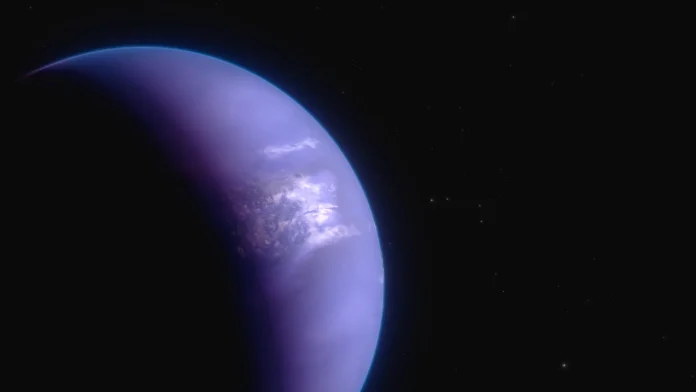
Using NASA’s James Webb Telescope researchers have revealed insights into the weather patterns of the hot gas-giant exoplanet WASP-43 b
This “hot Jupiter” exoplanet, is smaller and closer than the sun, it has a very tight orbit which means that one side is illuminated in light while the other is in darkness.
A recent study published in Nature Astronomy shows the dynamics of this distant world’s atmosphere.
The light and dark side of exoplanet WASP-43 b
Led by Taylor Bell of the Bay Area Environmental Research Institute, the team used the Webb Telescope’s ability to measure temperature variations and detect atmospheric gases across extended cosmic distances. Their findings reveal a contrast between the light and dark of WASP-43 b.
On the light side, temperatures reach 2,300 degrees Fahrenheit; there are also clear skies. However, on the dark side, temperatures drop to 1,100 degrees Fahrenheit, with thick, high clouds covering the atmosphere.
These clouds, gathered from precise brightness measurements and 3D climate models, play a key role in shaping the planet’s weather patterns.
The absence of methane: Why is this interesting?
The researchers discovered an absence of methane, which is a key atmospheric component expected on the cooler dark side.
This absence suggests the presence of ferocious equatorial winds, travelling in at 5,000 miles per hour, which efficiently mix atmospheric gases across the planet.
“The fact that we don’t see methane tells us that WASP-43 b must have wind speeds reaching something like 5,000 miles per hour,” explained Barstow. “If winds move gas around from the dayside to the nightside and back again fast enough, there isn’t enough time for the expected chemical reactions to produce detectable amounts of methane on the nightside.”
The rapid transport of gases prevents the buildup of methane, revealing the dynamic nature of WASP-43’s atmosphere.
Joanna Barstow from the Open University emphasised the significance of Webb’s observations in unravelling the mysteries of exoplanetary atmospheres. “Webb has given us an opportunity to figure out exactly which molecules we’re seeing and put some limits on the abundances,” she noted.










